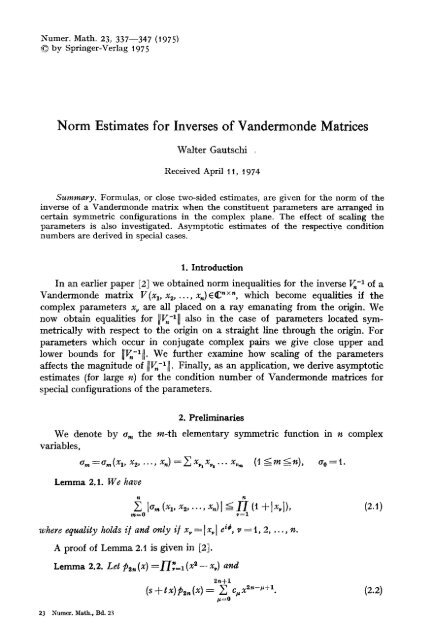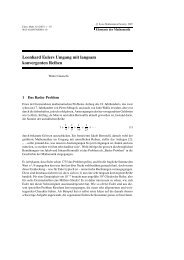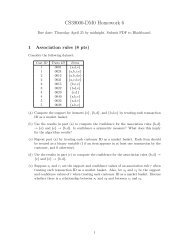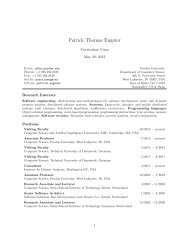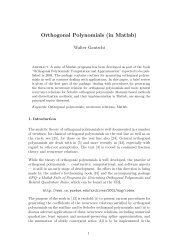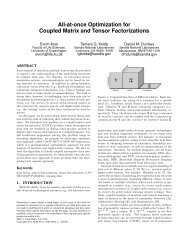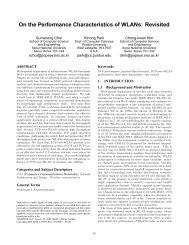Norm estimates for inverses of Vandermonde matrices
Norm estimates for inverses of Vandermonde matrices
Norm estimates for inverses of Vandermonde matrices
Create successful ePaper yourself
Turn your PDF publications into a flip-book with our unique Google optimized e-Paper software.
Numer. Math. 23, 337--347 (1975)<br />
9 by Springer-Verlag 1975<br />
<strong>Norm</strong> Estimates <strong>for</strong> Inverses <strong>of</strong> <strong>Vandermonde</strong> Matrices<br />
Walter Gautschi ,<br />
Received April 11, 1974<br />
Summary. Formulas, or close two-sided <strong>estimates</strong>, are given <strong>for</strong> the norm <strong>of</strong> the<br />
inverse <strong>of</strong> a <strong>Vandermonde</strong> matrix when the constituent parameters are arranged in<br />
certain symmetric configurations in the complex plane. The effect <strong>of</strong> scaling the<br />
parameters is also investigated. Asymptotic <strong>estimates</strong> <strong>of</strong> the respective condition<br />
numbers are derived in special cases.<br />
1. Introduction<br />
In an earlier paper [21 we obtained norm inequalities <strong>for</strong> the inverse V~ -1 <strong>of</strong> a<br />
<strong>Vandermonde</strong> matrix V(x~, x~ ..... x,) E IE "• which become equalities if the<br />
complex parameters x~ are all placed on a ray emanating from the origin. We<br />
now obtain equalities <strong>for</strong> live-ill also in the case <strong>of</strong> parameters located symmetrically<br />
with respect to the origin on a straight line through the origin. For<br />
parameters which occur in conjugate complex pairs we give close upper and<br />
lower bounds <strong>for</strong> Ilv,-xl]. We further examine how scaling <strong>of</strong> the parameters<br />
affects the magnitude <strong>of</strong> llV,-lll. Finally, as an application, we derive asymptotic<br />
<strong>estimates</strong> (<strong>for</strong> large n) <strong>for</strong> the condition number <strong>of</strong> <strong>Vandermonde</strong> <strong>matrices</strong> <strong>for</strong><br />
special configurations <strong>of</strong> the parameters.<br />
2. Preliminaries<br />
We denote by a,~ the m-th elementary symmetric function in n complex<br />
variables,<br />
a,~=am(xl, x2 ..... x~)= ~ x, x,..., x~ (1
338 W. Gautschi<br />
Then<br />
2.+1<br />
X le,,[ =
<strong>Norm</strong> Estimates <strong>for</strong> Inverses <strong>of</strong> <strong>Vandermonde</strong> Matrices 339<br />
For the coefficients cv in (2.5) we have<br />
c.=(--l)"(ta~--sa._~),<br />
where a-1 =a,.+~ =0. There<strong>for</strong>e,<br />
/*=0, l ..... 2n+t,<br />
2n 2n+l 2n+l 2n<br />
Ilsl-Itll Y I~,,I ~ Y Ic.I-- X It~-s~.-,I _-__(Isl +1~1) X I~.1,<br />
/~=0 /*=0 /~=0 /*=0<br />
from which (2.6) follows by virtue <strong>of</strong> (2.8).<br />
3. Inversion <strong>of</strong> the <strong>Vandermonde</strong> Matrix<br />
We denote the <strong>Vandermonde</strong> matrix <strong>of</strong> order n by<br />
' 1<br />
|<br />
! I<br />
n--I n--i n--lt<br />
Lxl x2 ...x, _1<br />
where xx, x~ ..... x~ are distinct complex numbers and n > t. Its inverse can be<br />
obtained by solving the system <strong>of</strong> linear algebraic equations<br />
ul + us +.-. + u, =vl<br />
x~u~ + x, m +... + x~ u,=v~ (3.2)<br />
9 ..+x,<br />
u~=v,.<br />
Introducing the elementary Lagrange interpolation polynomials<br />
l~(x) = /~/ x,-xx-~x-xa ----a~nxn--l + a ",n--~ x n-~ +... +a~v v=l, 2 ..... n, (3.3)<br />
/*=i<br />
p4:v<br />
which satisfy<br />
l~(x,) = {10<br />
if v=/t<br />
if v4=t*,<br />
it is evident that by multiplying the/,-th Eq. (3-2) by a,v,/, = t, 2 ..... n, and<br />
adding, we get<br />
Consequently,<br />
u~,=~avuvt,, v---~l, 2, ..., n.<br />
[all<br />
al, ... aa,]<br />
23*<br />
La,,1 an2 ... a~]<br />
4. <strong>Norm</strong> Inequalities <strong>for</strong> V; t<br />
We consider throughout the oo-norm <strong>of</strong> V~ -1,<br />
IIv.-~ll~o =max<br />
l
340 W. Gautschi<br />
Theorem<br />
Xl, x2, ..., x n.<br />
4.1. ][V-l(x~, x, ..... x,)[Ioo is a symmetric /unction in the variables<br />
Proo/. Interchanging two variables amounts to interchanging two columns<br />
<strong>of</strong> Vn, which in turn has the effect <strong>of</strong> interchanging two rows <strong>of</strong> V~ -1. The value<br />
<strong>of</strong> ]]V,-X[[| remains the same.<br />
Theorem 4.2. Let to 4=0 be arbitrary complex, and<br />
v, (o,) =~v(o, xl, ox~ ..... ~, x~).<br />
The. IIV;' (o)lL aepe~as only on 1~1 a~a is smctly decreasing as a/unction o~ I~l-<br />
Proo/. Let K =K(I), IT, -1 = [a,,]. Since<br />
we have V. -x (r<br />
V.(o~) =D(co)V~, D(r =diag(l, o) ..... 60"-1),<br />
=Vn-xn -1 (~o), i.e.,<br />
~-~(o)=[ a,. 1 [ o~v-1 ]' v,l~=t,2 ..... n.<br />
It is clear, there<strong>for</strong>e, that the norm <strong>of</strong> V~ -1 (to) depends only on ]to]. Furthermore,<br />
if 1~11 O, v=l, 2 ..... n,<br />
in which case the equality in (4.t) can be given the alternative <strong>for</strong>m<br />
where<br />
iiV-~ll~ =<br />
Ip.(-~)l<br />
min {(! +x,)IP;(*,)I} (x,>0), (4A')<br />
x
<strong>Norm</strong> Estimates <strong>for</strong> Inverses <strong>of</strong> <strong>Vandermonde</strong> Matrices 341<br />
origin. In view <strong>of</strong> Theorem 4.2 we may assume the straight line to coincide with<br />
the real axis.<br />
Theorem 4.3. Let x, be distinct real numbers such that<br />
I/V~ = V(x 1, x, ..... x,), we then have<br />
x, + x,+l_ , = 0, v = t, 2 ..... n. (4.4)<br />
[! 2 max . {(t + !) *. v./i I"; l+x~ - d l } i! n is even,<br />
IV.-1L = (4.5)<br />
/max/~.(t + x.//-/i ,--~/. t + ~'~ i/.isoaa,<br />
I " t ~4, ix,-%lJ<br />
where v and p vary over all integers !or which x, >= 0 and x~, > O, respectively, and<br />
where e, = ~ when x, > O, and e, = 1 when x, = O. Alternatively,<br />
lie_, L =<br />
Ip.(01 t +x,* I}' (4.5')<br />
min, ( t~--~v Ipg(x,)<br />
where p~ ( x) is the polynomial in (4-3), and the minimum is taken over all nonnegative<br />
abscissas.<br />
Proo/. For the sake <strong>of</strong> definiteness we assume<br />
x,>0 <strong>for</strong> v=t, 2 ..... [n/2], x(,+l)/~=O if n is odd. (4.6)<br />
Let first n be even. The Lagrange polynomials (3.3) then are<br />
z,(x)- "+'./~''-~ l~§ v=1,2 ..... --~.<br />
/~4:v<br />
It suffices in (3.4) to evaluate the sums ~.~=~]a,,] <strong>for</strong> t _~, n/2) having the same values. An application <strong>of</strong> (3.3), (3.4) and Lemma 2.2,<br />
in which n is to be replaced by (n/2) --t, and s and t by<br />
1 t<br />
.12<br />
2 H (~:- d)<br />
hi2<br />
2 ~,, H (,~*.- ~,)<br />
$ - - ' ~ - - "<br />
la:4:t,<br />
then gives the first result in (4.5). The second, <strong>for</strong> n odd, is obtained similarly,<br />
noting that<br />
l, (~) , , l,,+~_.(~) =l.( - x), ~, = t, 2 .... - -<br />
X v 2X~ "~'j['l~l X v - - X~ ~ 2 '<br />
t, eev<br />
(.--1)12 Xi -- X~<br />
l(..)/~(x)= H (-d)"<br />
The alternative <strong>for</strong>m (4.5') follows readily from (4.5) by observing that<br />
n/2<br />
p,(x) =H(x~-x~)<br />
p=1<br />
~eet'<br />
if n is even,
342 W. Gautschi<br />
and<br />
(n - 1)/2<br />
p, (x) = x H ( x2 - x~) if n is odd.<br />
Corollary. I/n is even and x, are symmetric points as in (4.4), then (4.t) holds<br />
with strict inequality.<br />
Proo/. The bound in (4A), again assuming (4.6), is<br />
I ' ./2 (1 + x/*)~<br />
max ,(t+~)/__/1 [x--~ x~ j,<br />
z l
<strong>Norm</strong> Estimates <strong>for</strong> Inverses <strong>of</strong> <strong>Vandermonde</strong> Matrices 343<br />
Let<br />
5. Scaling <strong>of</strong> the Abscissas<br />
V.(co) = V(to xl, oJ x~ ..... to x.), to > 0.<br />
How does the norm <strong>of</strong> V~-l(to) compare with the norm <strong>of</strong> V,-X(l)? We shall<br />
answer this question first <strong>for</strong> positive abscissas x,, and then <strong>for</strong> symmetric real<br />
abscissas.<br />
Theorem 5.1. Let x, be distinct positive numbers. Then ]or to > O,<br />
o,+1 p.(-l) < Hv;'o)llo~<br />
where p,(x) is the polynomial in (4.3).<br />
Proo[. From (4A') we obtain<br />
344 W. Gautschi<br />
We need to show that<br />
2(~ - !) ~ + !<br />
-~i 0 assumes the minimum value 2 (1/2 -- t) at y = V ~ - t.<br />
if t > 1, we use the first identity in (5.4) to obtain again<br />
go(O ><br />
i 2(1/~-1) _ 2(~-1)<br />
to 1<br />
--+t<br />
co+l<br />
co<br />
Combining the left inequality in (L3) just established with the second identity<br />
in (5.4) gives the right inequality, and thus proves (5.3).<br />
6. Examples<br />
<strong>Norm</strong> <strong>estimates</strong> <strong>for</strong> V~ -1 imply <strong>estimates</strong> <strong>for</strong> the condition number <strong>of</strong> V,.<br />
These in turn are <strong>of</strong> interest, e.g., in the study <strong>of</strong> the condition <strong>of</strong> polynomial<br />
interpolation [3]. In the examples which follow we derive asymptotic <strong>estimates</strong><br />
<strong>for</strong> the condition number, assuming typical configurations <strong>of</strong> interpolation points.<br />
Example 6.1 (equidistant points), xv=t 2(v-l) n-I , v=l,2 .... ,n. We<br />
assume first n even. From (4.5) we find after some computation that<br />
where<br />
0s n<br />
V;1L - rain ~,'<br />
l
<strong>Norm</strong> Estimates <strong>for</strong> Inverses <strong>of</strong> <strong>Vandermonde</strong> Matrices 345<br />
For n odd, we find similarly,<br />
sinh (r ~[n +1 . n--t~2<br />
V;q = z~(_~_t 7:1 .~ )! , "~ -t-~--~-} (n odd). (6.1o)<br />
Since<br />
condoo Vn = I1= =-I1 I1 , (6.2)<br />
using Stirling's <strong>for</strong>mula <strong>for</strong> the gamma function, and straight<strong>for</strong>ward, but<br />
tedious, manipulations, we find from (6.t) that<br />
1 _n n 1<br />
condoo V.,~ ~ e ~ e"(u +-~-'n*), n-+~. (6.3)<br />
Some numerical values x are listed in Table t.<br />
Table 1. Condition <strong>of</strong> polynomial interpolation at equidistant points on ~- 1, 1 ]<br />
n condo0 V n (6.3)<br />
5 5.0000 (1) 4.t668 (I)<br />
t0 1.3625 (4) t.1963 (4)<br />
20 1.0535 (9) 9.8614 (8)<br />
40 6.9269 (t8) 6.7007 (18)<br />
80 3.1456 (38) 3.0937 (38)<br />
2~-- 1<br />
Example 6.2 (Chebyshev points), x~ =cos 0~, 0, = 2n -~' v =1, 2 ..... n.<br />
The abscissas x, are the zeros <strong>of</strong> the Chebyshev polynomial <strong>of</strong> the first kind,<br />
T,~(x). Hence, by (4.5'), since [T'(x,) I =n/sin 0,, we find that<br />
where<br />
I1 - 11 -<br />
[ T~ (i)[<br />
.. mini(0,) '<br />
! +cos ~ 0<br />
1(0) = (t +cos 0) sin 0' o
346 W. Gautschi<br />
it then follows that<br />
Consequently, by (6.4),<br />
min/(0,,,)-->/(0o)<br />
v<br />
33/4<br />
as n -+oo.<br />
/r ---> oo.<br />
On the other hand [4, p. 194],<br />
I Z,(r ~(l + lf2:,<br />
so that, in view <strong>of</strong> (6.2),<br />
3314<br />
cond| V~ ,~ ~- (l + ]/2)",<br />
Some numerical values are listed in Table 2.<br />
T/; -& oo<br />
n -+ oo.<br />
(6.5)<br />
Table 2. Condition <strong>of</strong> polynomial interpolation at Chebyshev points<br />
n condoo V n (6.5)<br />
5 4.1000 (t) 4.6737 (t)<br />
tO 3.7495 (3) 3.8330 (3)<br />
20 2.5727 (7) 2.578t (7)<br />
40 1.1663 (15) 1.1663 (t5)<br />
80 2.3859 (30) 2.3869 (30)<br />
Example 6.3. x,=t --e -i'~ v=t, 2 ..... n (even), h > O,<br />
0
<strong>Norm</strong> Estimates <strong>for</strong> Inverses <strong>of</strong> <strong>Vandermonde</strong> Matrices 347<br />
Example 6.4 (Roots <strong>of</strong> unity), x, =e 2~i'/", v-----l, 2, ..., n.<br />
Although none <strong>of</strong> the previous <strong>estimates</strong> apply, we can obtain the inverse <strong>of</strong><br />
the <strong>Vandermonde</strong> matrix directly by observing that the Lagrange interpolation<br />
polynomials are<br />
t,(x)=~- ~.~/ , ~=1,2 ..... n.<br />
Consequently, by (3.3), (%4),<br />
IIv/*u| =t, cond V ---n.<br />
Actually, the roots <strong>of</strong> unity are an optimal point configuration with regard<br />
to the spectral condition <strong>of</strong> <strong>Vandermonde</strong> <strong>matrices</strong> [3 ]. In fact, since V ff V~ = n 9 I,,<br />
we have cond2V ~ = t.<br />
References<br />
1. Bettis, D. G. : Numerical integration <strong>of</strong> products <strong>of</strong> Fourier and ordinary polynomials.<br />
Numer. Math. 14, 421-434 (1970)<br />
2. Gautschi, W. : On <strong>inverses</strong> <strong>of</strong> <strong>Vandermonde</strong> and confluent <strong>Vandermonde</strong> <strong>matrices</strong>.<br />
Numer. Math. 4, 117-123 (1962)<br />
3. Singhal, K., Vlach, J. : Accuracy and speed <strong>of</strong> real and complex interpolation.<br />
Computing 11, 147-158 (1973)<br />
4. Szeg6, G. : Orthogonal polynomials, 2nd rev. ed., Amer. Math. Soc. Colloq. Publ.,<br />
Vol. 23, Amer. Math. Soc., Providence, R.I., 1959<br />
Pr<strong>of</strong>. W. Gautschi<br />
Department <strong>of</strong> Computer Sciences<br />
Purdue University<br />
Lafayette, Indiana 47907~U.S.A.


